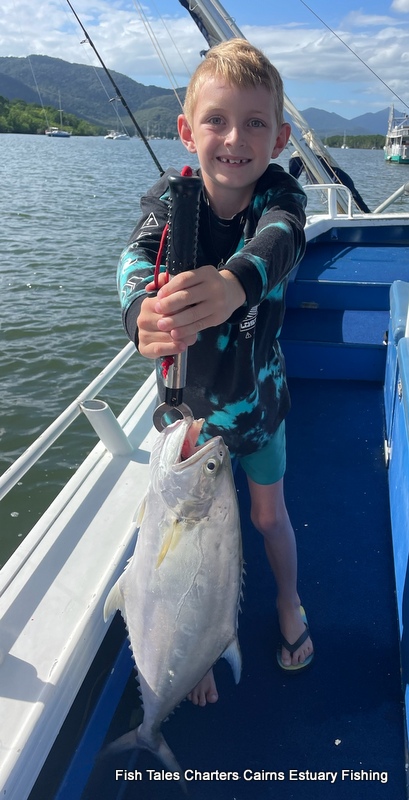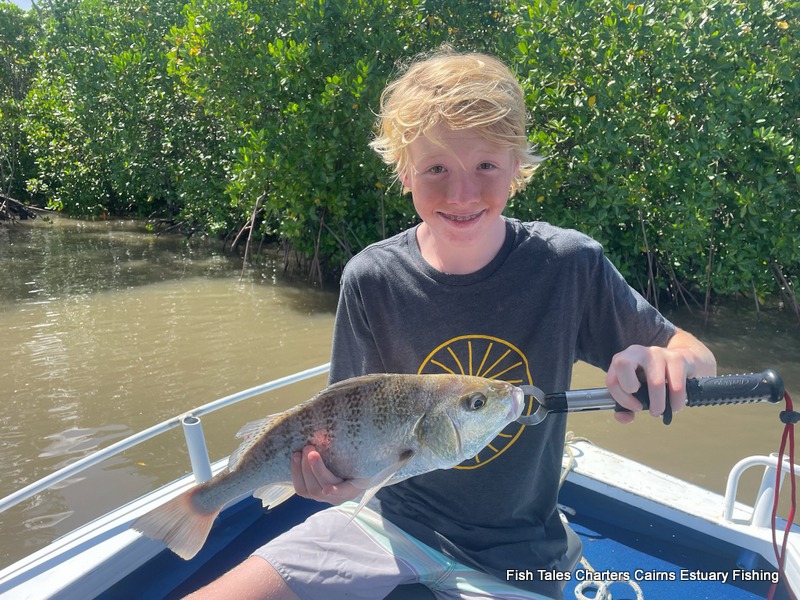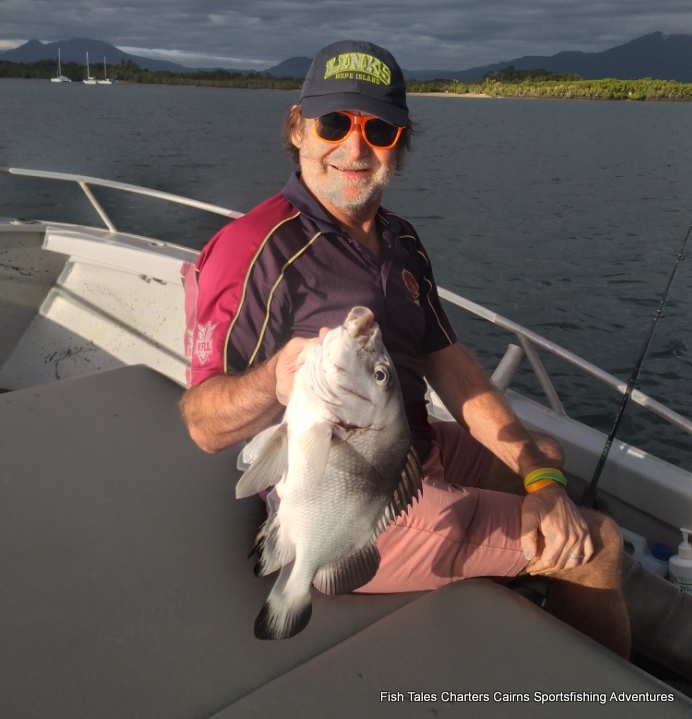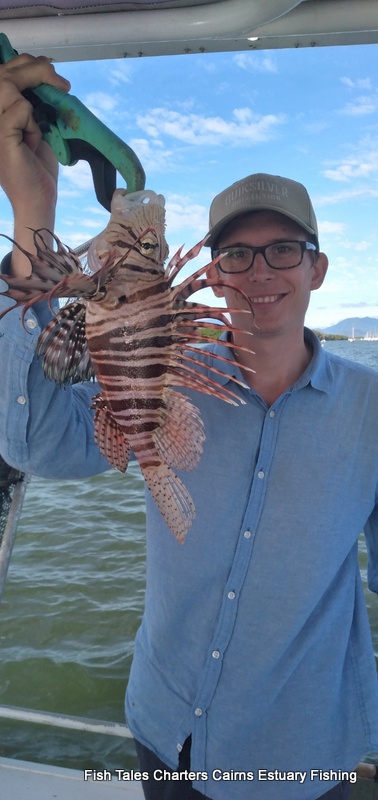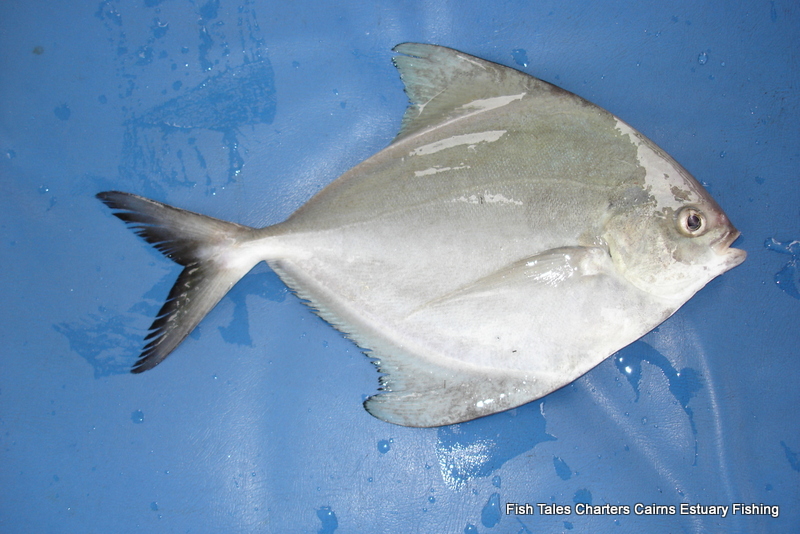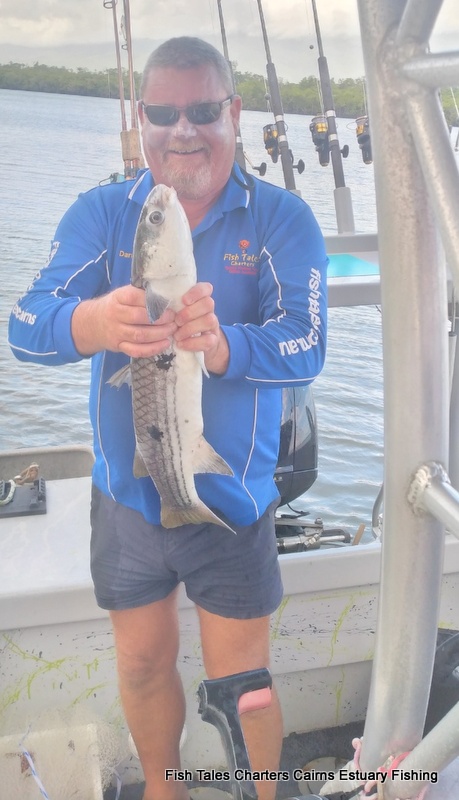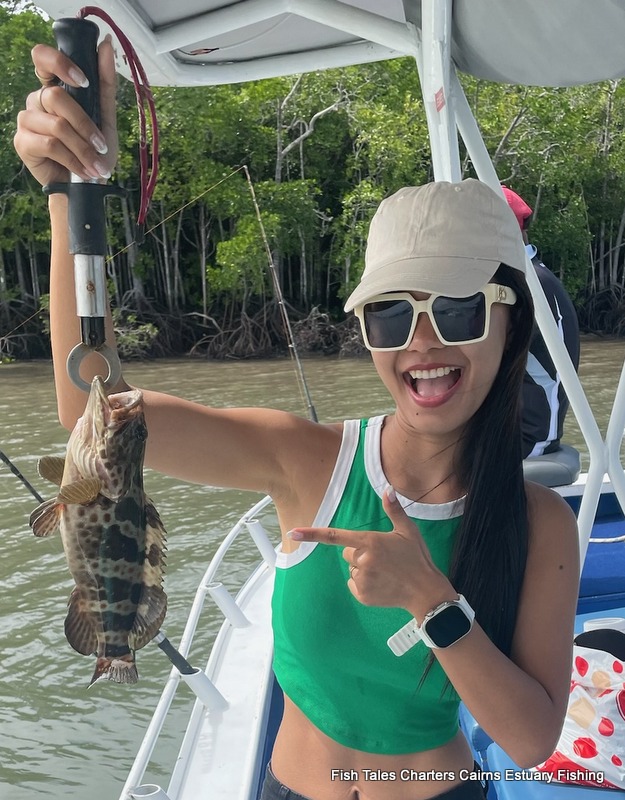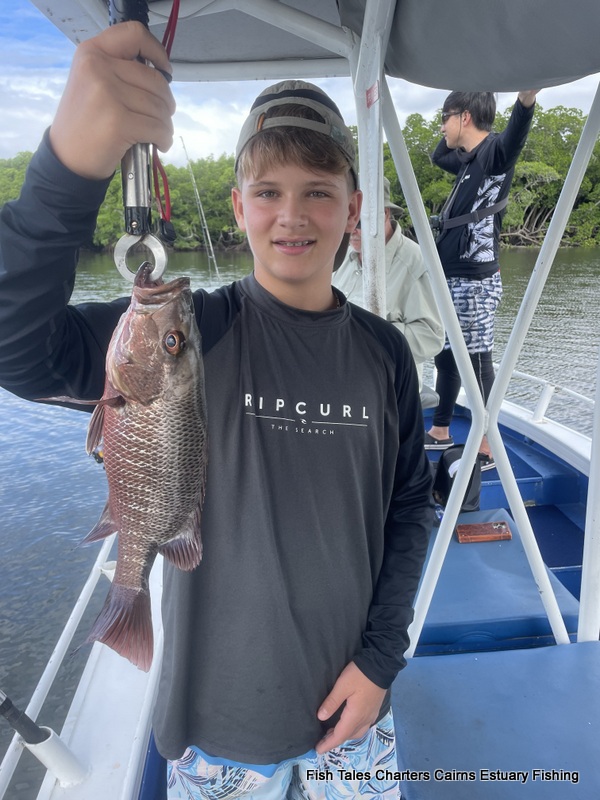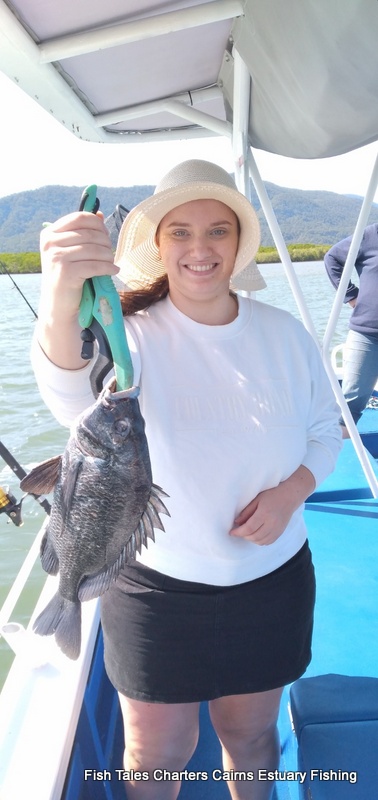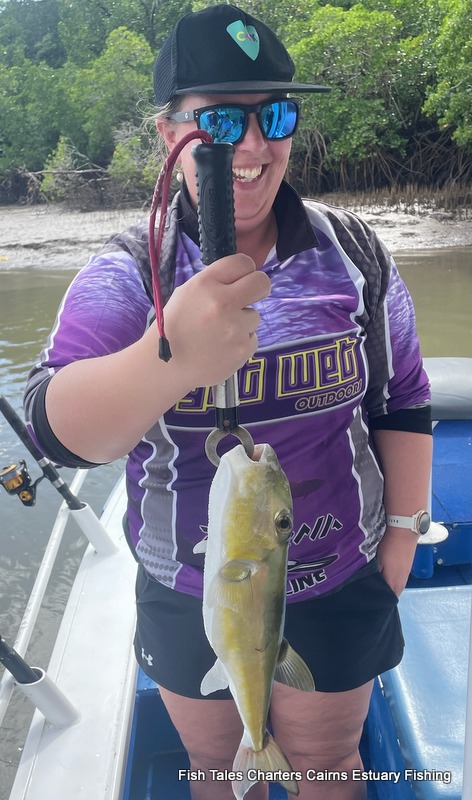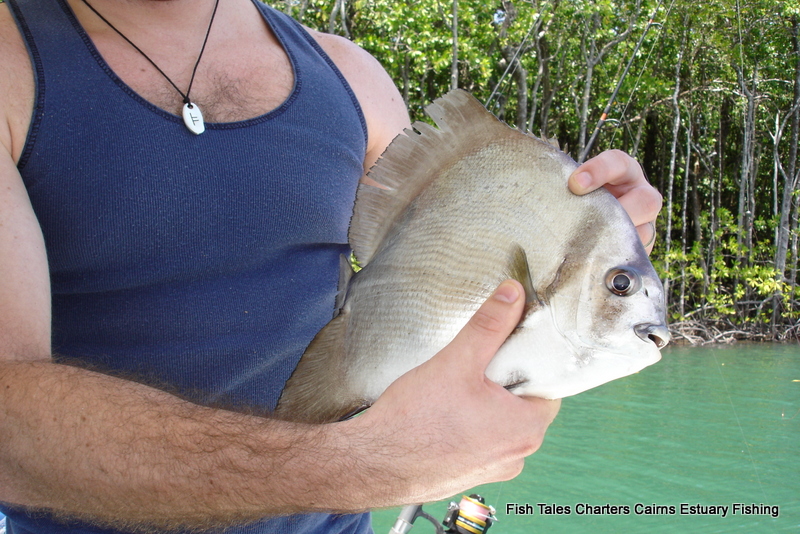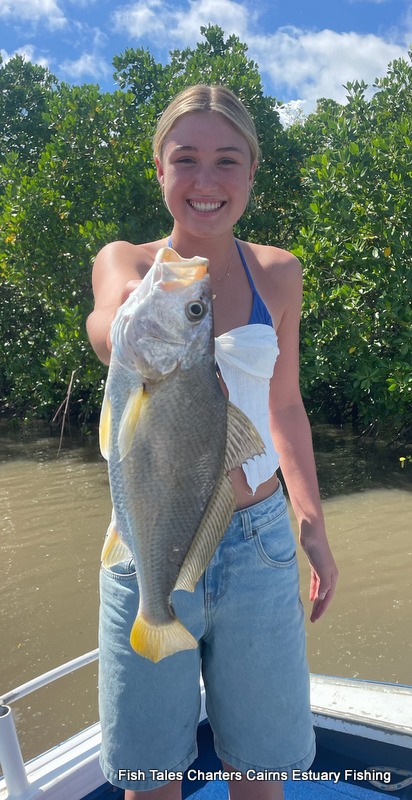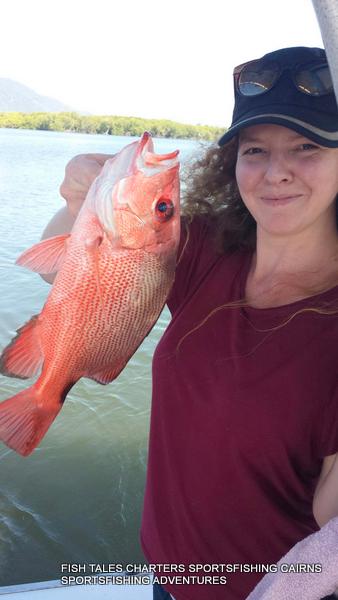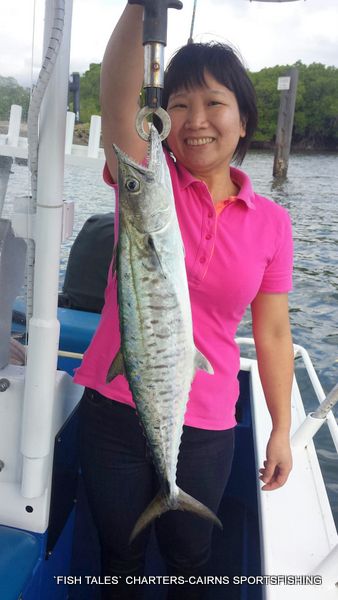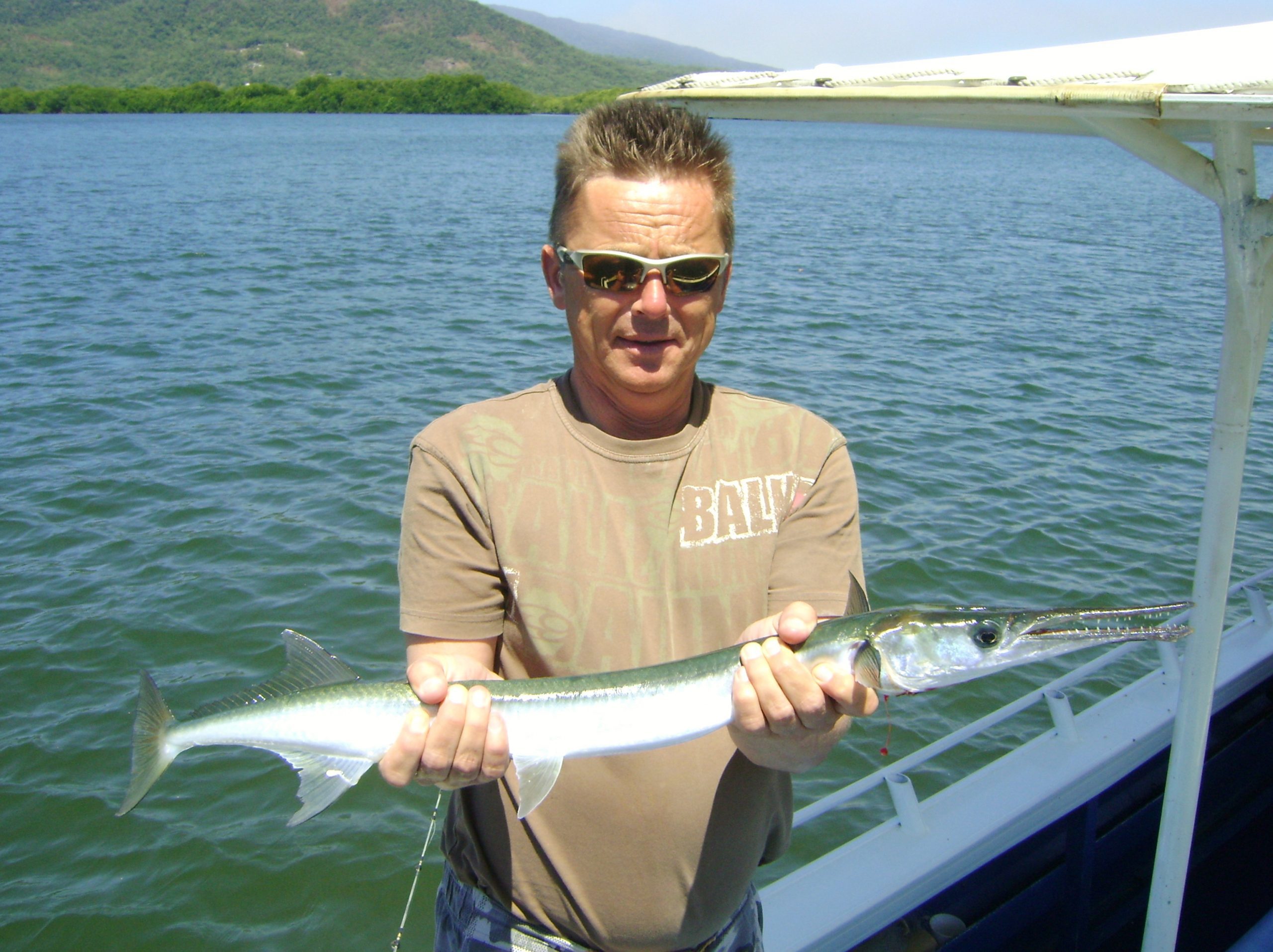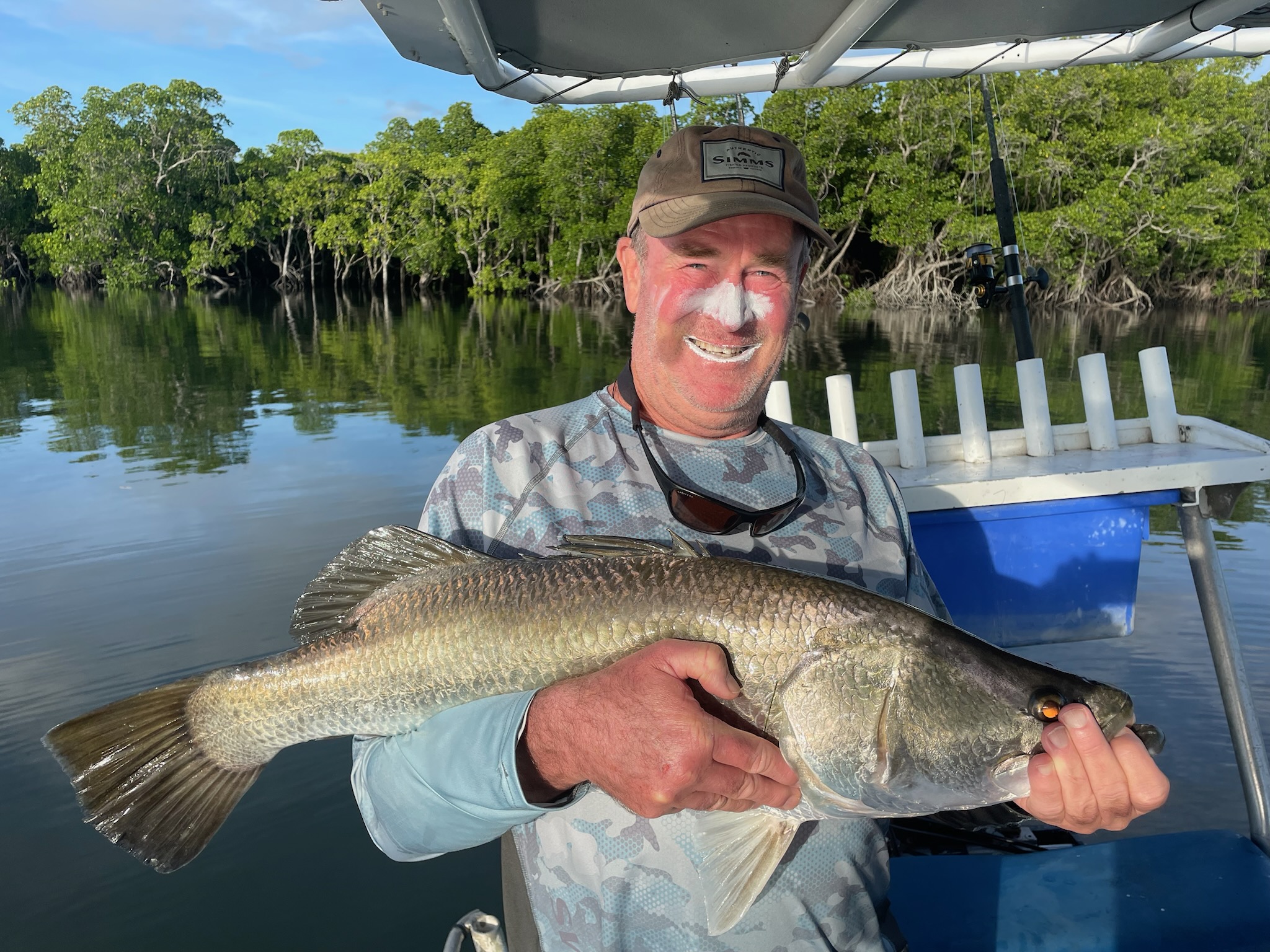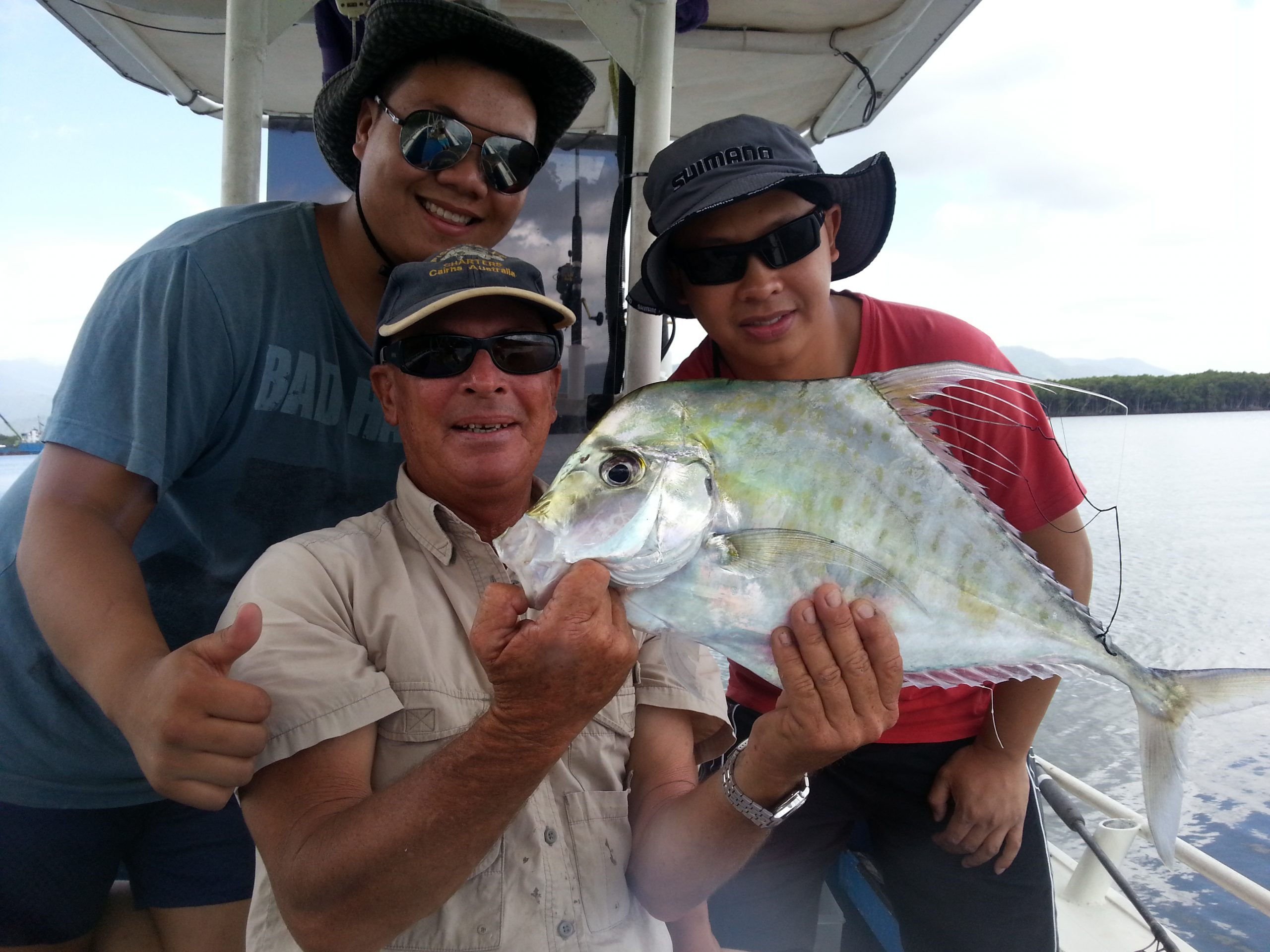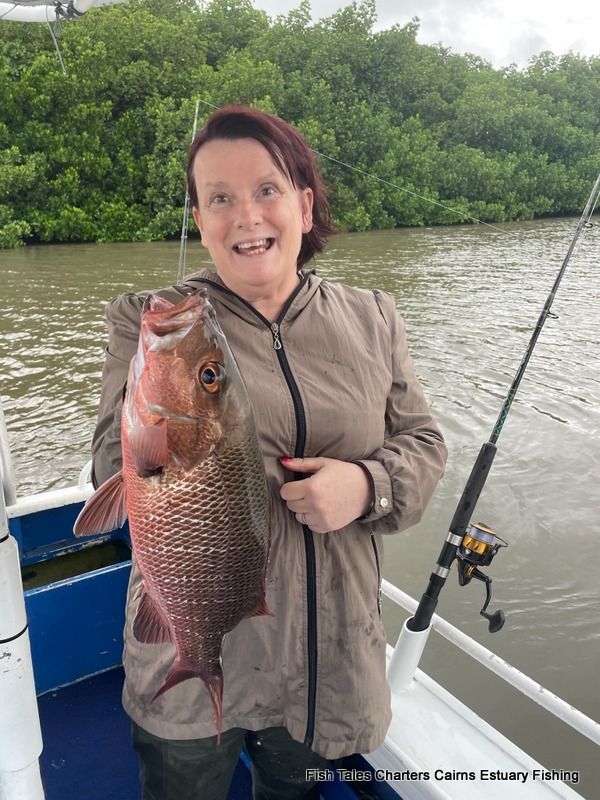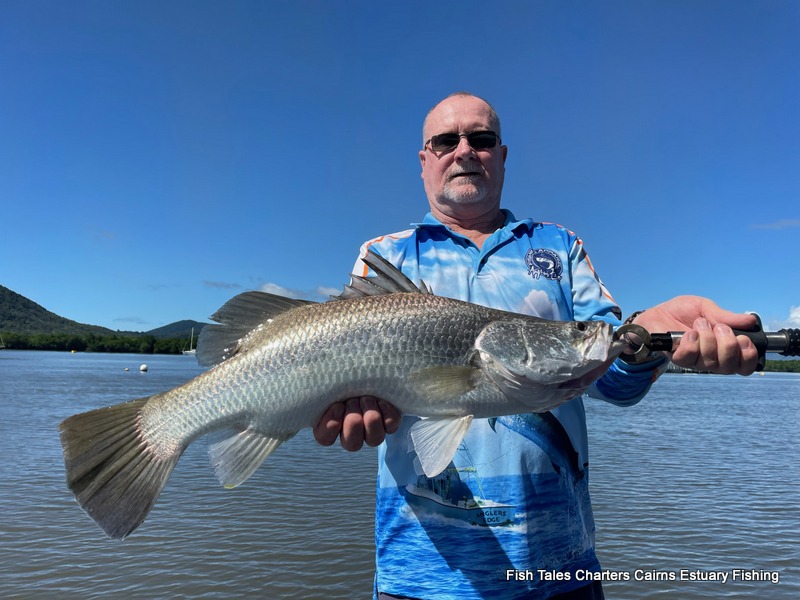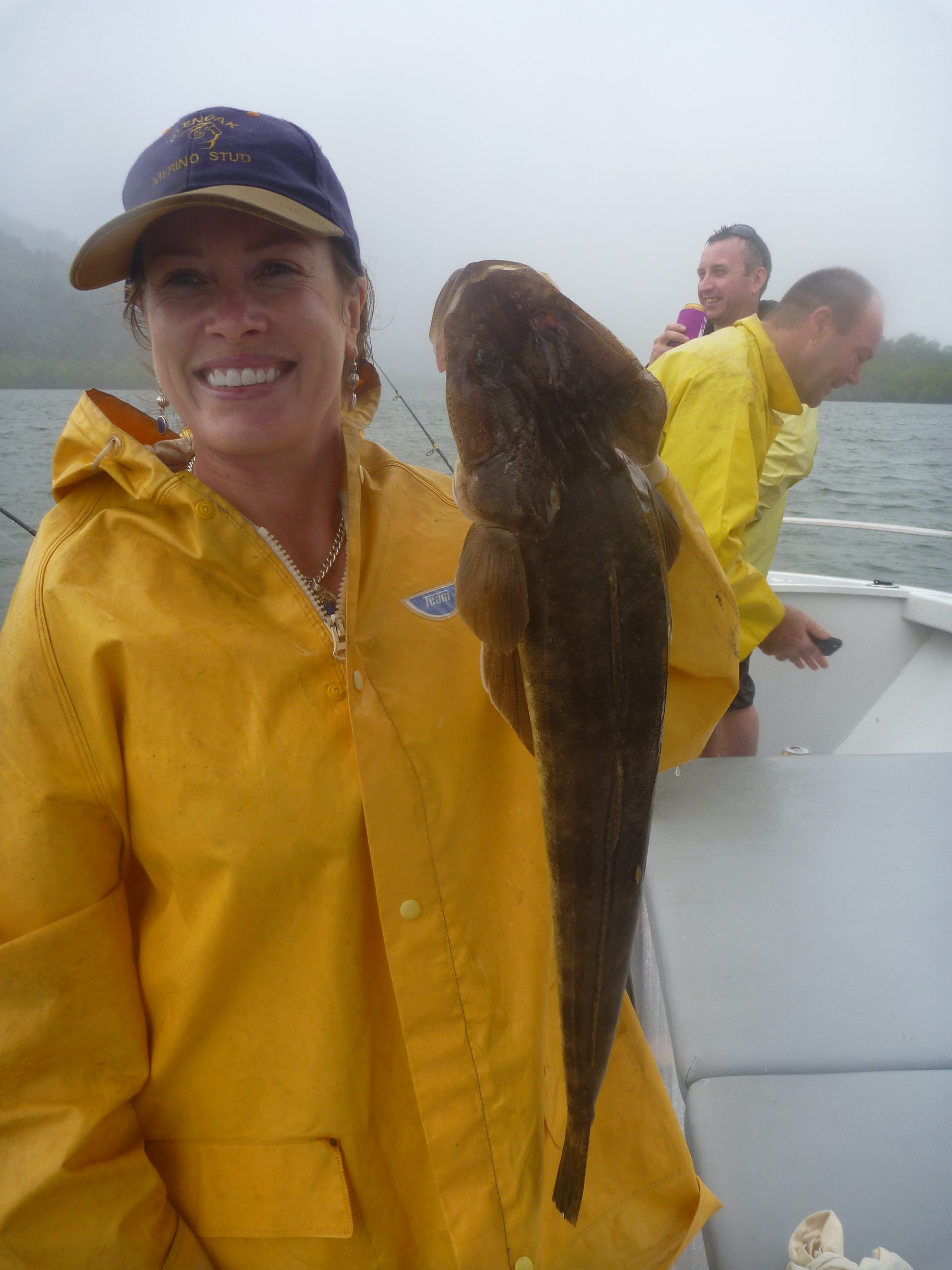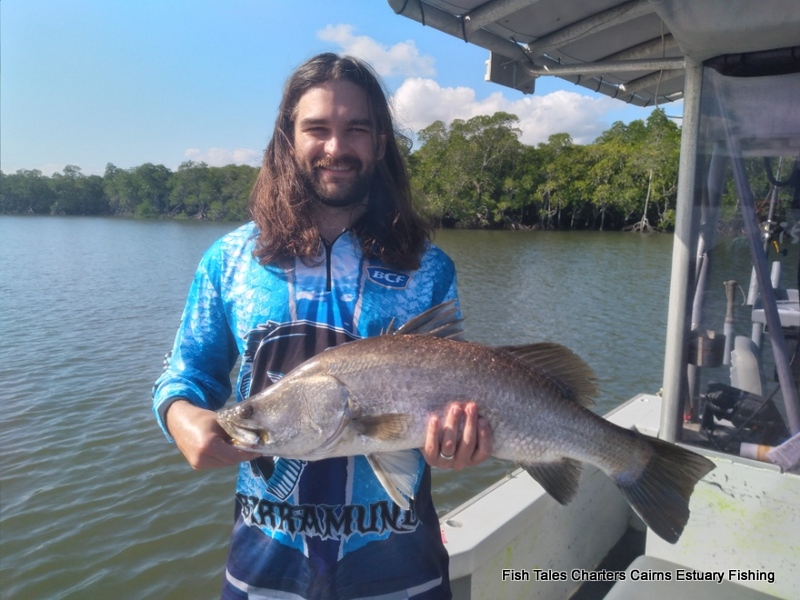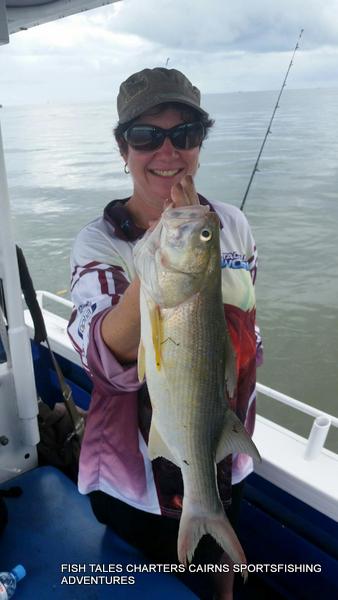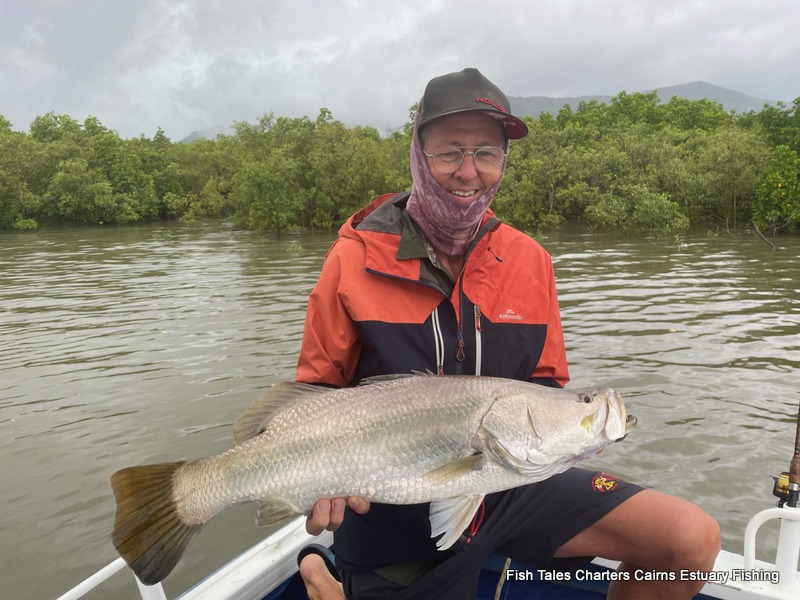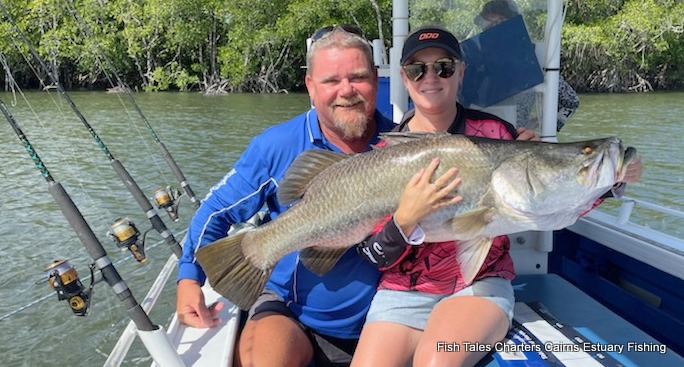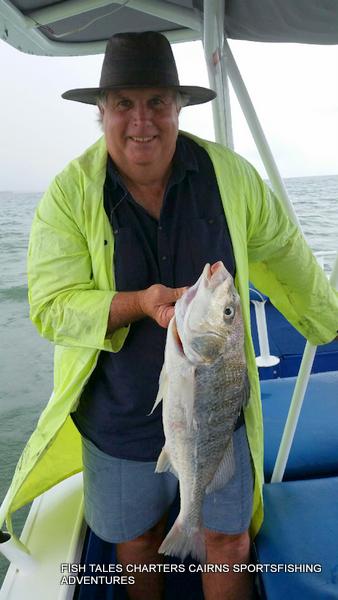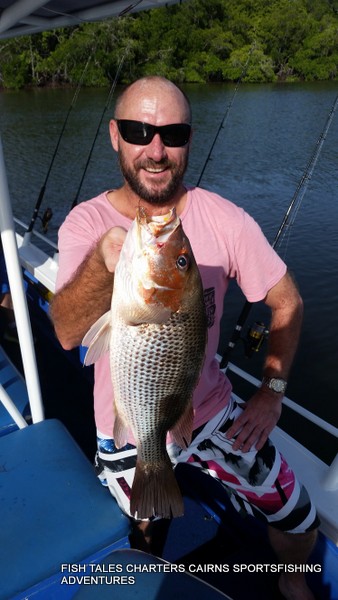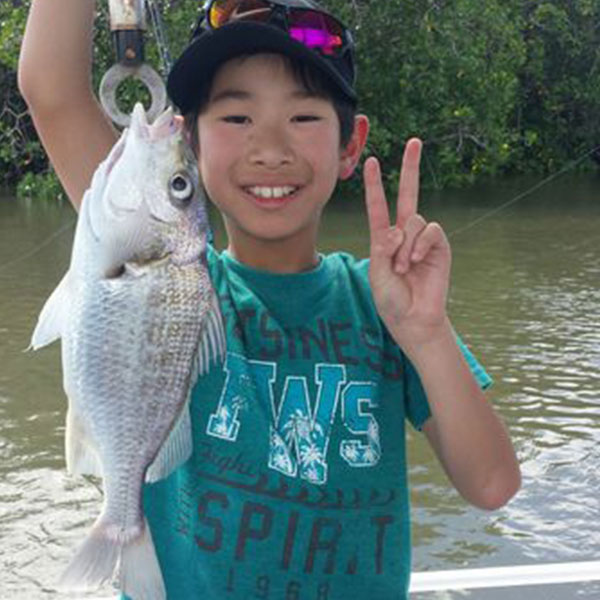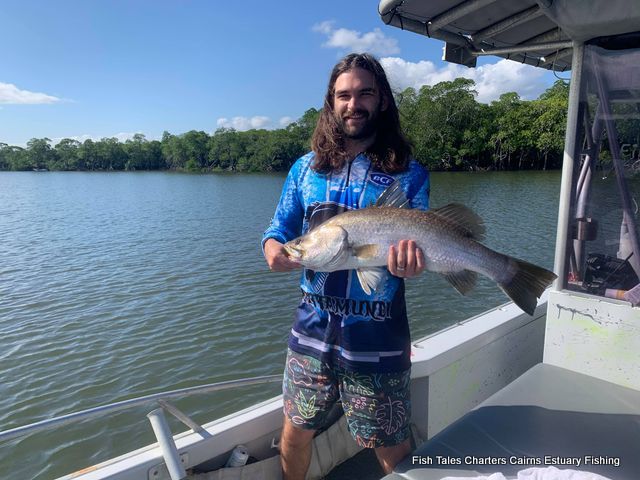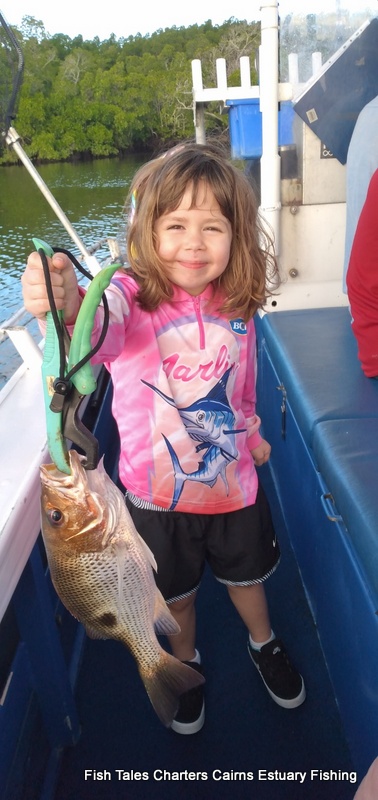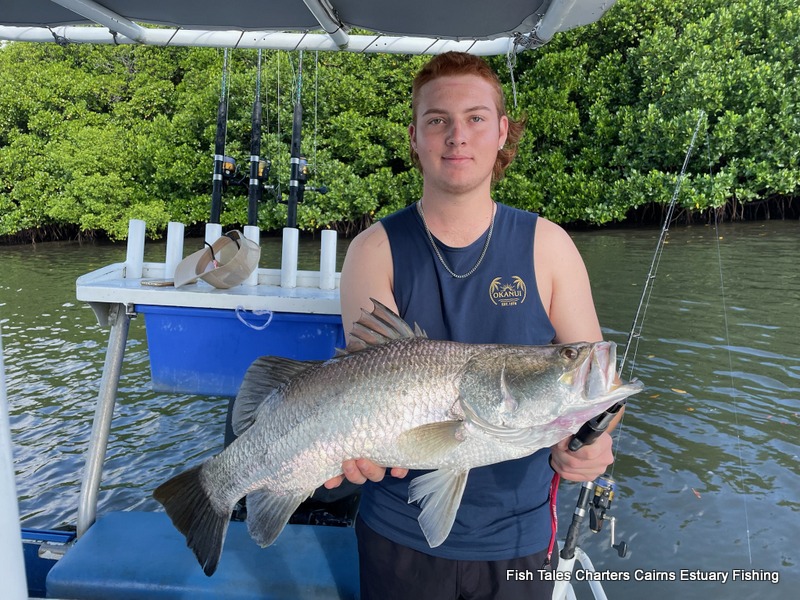Cairns Estuary Fishing Tours
The Cairns Estuary System of Trinity Inlet is made up of open waters, creeks and a deep channels; these have the making of a paradise for anglers and fishermen alike. Cairns, Trinity Inlet is a State Marine Park, this natural habitat has numerous deep holes, mudflats, snags, and drop-offs making it a great location to catch a variety of fish species. The Cairns Estuary area has over 100kms of waterways just at our backdoor, so let us show you our backyard.
Common species of fish caught when Fishing in Cairns Inlet are Fingermark, Mangrove Jack, Estuary Cod, Grunter (Javelin Fish), Salmon, Queen Fish (Queenies), GT’s (Trevally), Thread Fin Salmon, Bream, Mud Crabs and ‘Every Cairns fisherman’s dream’ … The Barramundi! Check out the photo gallery to see our happy customers with their catch, this could be you!
The gear we supply is PENN 460 slammers reel on a 8-10 kg ugly stick with 10 kg mono fishing line. If you prefer you can bring along your own fishing gear.
Check out our fish gallery https://fishtales.com.au/fish-gallery/
Barramundi Closure
Throughout the Queensland east coast, a closed season applies to Barramundi from 12:01 am 1st November to 11:59 pm 31st January inclusive each year. It is prohibited to deliberately target Barramundi for catch and release during these closed seasons, as the stress may prevent a fish from spawning. More information can be found https://www.daf.qld.gov.au/business-priorities/fisheries/recreational/recreational-fishing-rules/closed-seasons-waters/tidal-waters
CAIRNS ESTUARY FISHING
Half and/or Full Day Share Charter (max 6 passengers)
Morning Fishing Charter
6.30am to 11.00pm
Maximum of 6 people per charter
Bait (live/dead) fishing
Your morning estuary fishing charter starts with the beginning of gathering live bait via a cast net by our experienced fishing guide before moving up into the estuary of Trinity Inlet, Cairns. Actual fishing locations maybe chosen based on prevailing weather and tidal conditions. We ask you to met at the Cairns Marlin Marina on Finger D berth 2 at 6.30am.
We supply the following
- All top quality rods and PENN SLAMMER reels,
- All bait (dead/live) and tackle,
- Along with cooled bottled water,
- and you will be guided by our experienced fishing guide.
We ask you to wear and bring onboard
- A long sleeve cotton shirt and wide brim hat; along with your sunnies, sunscreen, camera and a few cans are okay.
Require more information? Email us
$120 per person
Afternoon Fishing Charter
From 11:00am to 4.00pm
Maximum of 6 people per charter
Bait (live/dead) fishing
Your afternoon estuary fishing charter starts with the beginning of gathering live bait via a cast net by our experienced fishing guide before moving up into the estuary of Trinity Inlet, Cairns. Actual fishing locations maybe chosen based on prevailing weather and tidal conditions. We ask you to met at the Cairns Marlin Marina on Finger D berth 2 at 11.30am.
We supply the following
- All top quality rods and PENN SLAMMERS reels,
- all bait (dead/live) and tackle,
- Along with cooled bottled water
- and you will be guided by our experienced fishing guide.
We ask you to wear and bring onboard
- A long sleeve cotton shirt and wide brim hat; along with your sunnies, sunscreen, camera and a few cans are okay.
Require more information? Email us
$120 per person
Full Day Fishing Charter
From 6.30am to 11.00am then 11.30am to 4.00pm. Please note there is no lunch supplied
Maximum of 6 people per charter
Bait (live/dead) fishing
Both the morning and afternoon estuary fishing charter starts with the beginning of gathering of live bait via a cast net by our experienced fishing guide before moving up into the estuary of Trinity Inlet, Cairns. Actual fishing locations maybe chosen based on prevailing weather and tidal conditions. On our full day estuary fishing charter the vessel comes back to the Cairns Marlin Marina for one hour. At the Pier Shopping Centre and along the Cairns Esplanade their are takeaway outlets and restaurants to organise lunch. Our morning fishing charter we ask you to meet at 6.30 am; our afternoon fishing charter we ask you to meet at 11.30 am, their is 4.5 hours of fishing to do!
We supply the following
- All top quality rods and PENN SLAMMER reels,
- All bait (dead/live) and tackle,
- Along with cooled bottled water,
- and you will be guided by our experienced fishing guide.
We ask you to wear and bring onboard
- A long sleeve cotton shirt and wide brim hat; along with your sunnies, sunscreen, camera and a few cans are okay.
Require more information? Email us
$240 per person
- Transfers Fee may apply, arrangements to be made at the time of booking your fishing Charter.
- *NOTE – Your charter returns to our berth at the Marlin Marina (located next to the Pier Shopping centre/Shangrila Hotel).
- We leave the decision for the next hour to you; why not have lunch at Tha Fish (fish & chips & salad), or Mondos in front of the Hilton Hotel, then a refreshing swim in the Lagoon on the Cairns Esplanade, or maybe shopping in the The Pier Shopping Centre is more your style , the choice is yours!!
CAIRNS ESTUARY FISHING PRIVATE CHARTERS
Morning Fishing Charter
6.30am to 11.00am
Up to 6 people for bait (live/dead) fishing only
Up to 3 people for lure/popper fishing only
Your morning estuary fishing charter of saltwater fishing the open waters, creeks and deep channel of the Cairns Estuary System known as Trinity Inlet, Cairns. Actual fishing locations maybe chosen based on prevailing weather and tidal conditions. For your live bait fishing charter, your charter will start with the gathering of live-bait via a cast net by your fishing guide before moving up into the Cairns estuary system. Met at the Cairns Marlin Marina on Finger D berth 2 at 6.30 am.
We supply the following
- All top quality rods and PENN SLAMMERS reels,
- All bait (dead/live) and tackle,
- All lures/poppers (supplied on a replaced if lost basis),
- Along with cooled bottled water and you will be guided by our experienced fishing guide.
We ask you to wear and bring onboard
- A long sleeve cotton shirt and wide brim hat; along with your sunnies, sunscreen, camera and a few cans are okay.
Require more information? Email us
$720 per half day
Afternoon Fishing Charter
11.30am to 4.00pm
Up to 6 people for bait (live/dead) fishing only
Up to 3 people for lure/popper fishing only
Your afternoon estuary fishing charter of saltwater fishing the open waters, creeks, and the deep channel of the Cairns Estuary System known as Trinity Inlet, Cairns. Actual fishing locations maybe choosen based on prevaiing weather and tidal conditions. For live bait fishing charters, your charter will start with the gathering of live bait via a cast net by our experienced fishing guide before moving up into the Cairns estuary system. We ask you to met at the Cairns Marlin Marina on Finger D berth2 at 11.30am.
We supply on all our charters
- All top quality rods and PENN SLAMMERS reels,
- All bait (dead/live) and tackle,
- All lures/poppers (lures & poppers supplied on the basis if lost to be replaced)
- Along with cooled bottled water and you will be guided by our experienced fishing guide.
We ask you to wear and bring onboard
- A long sleeve cotton shirt and wide brim hat; along with your sunglasses, sunscreen, camera and a few cans are okay.
Require more information? Email us
$720 per half day
Full Day Fishing Charter
6.30am to 3.30pm
Up to 4 people for bait (live/dead) fishing only
Up to 3 people for lure/popper fishing only
Your full day of estuary fishing of saltwater fishing the open waters, creeks and deep channel of the Cairns Estuary System also known as Trinity Inlet, Cairns. Actual fishing locations maybe chosen based on the prevailing weather and tidal conditions. For live bait fishing your charter will start with the gathering of live bait via a cast net by our experienced fishing guide before moving up into the Cairns estuary system. For lure and or popper fishing charters are supply, NOTE these are supplied on the basis if lost or broken, these are to be replaced. We ask you to met at the Cairns Marlin Marina on Finger D berth 2 at 6.30 am.
We supply the following
- All rods and PENN SLAMMER reels,
- All bait (dead/live) and tackle,
- All lures/poppers (supplied on basis if lost to be replaced basis),
- Along with a delicious lunch,
- Cooled bottled water and you will be guided by our experienced fishing guide.
We ask you to wear and bring onboard
- A long sleeve cotton shirt and wide brim hat; along with your sunglasses, sunscreen, camera & a few cans are okay.
Require more information? Email us
$960 per full day
COMMONLY CAUGHT
ESTUARY FISH SPECIES
Australian Barracuda
Sphyraena novaehollandiae
The Australian barracuda has a greenish back with silvery flanks to which fades to white on the belly with greenish-yellow tail. Has a protruding lower jaw with a conical snout. Prefer cooler inshore waters with patches of seagrass/seaweed or sandy areas. This is a pelagic fish species; an opportunistic predator, that can live up to 20 years.
Barramundi
Late calcarifer
Barramundi also referred to as a Barra. Has a soft and delicate white flesh; size is generally to 150 cm and 60 kg. The minimum size limit of 58 cm to maximum size limit of 120 cm and has a closed season from 1st November to 31st January each year to allow for spawning. Starts life out living in Freshwater of rivers and creeks, then ventures downstream into estuaries and coastal shallows. They are well-known and sought-after for their aerobic abilities when hooked.
Barred javelin
Pomodasys kaakan
In Cairns, we refer to them as `Grunter` from their characteristic `grunting` sound by grinding the teeth in the back of there throat. Can grow up to 70 cm and 5 kg. Has a minimum size limit of 40 cm. The flesh is firm with a distinctive flavour and an excellent table fish.
Black Jewfish
Protonibea diacanthus
NOTE: Black jewfish is a no-take species strong for all fishers for the rest of the 2022 calendar year as it has reached it`s Total Allowable Commercial Catch; this is both commercial and recreational. Most common size to 150 cm but has a size limit of 75 cm with a limit of 1. Can live on sand and mud from the Continent shelf to inshore coastal habitats and estuaries. Well regarded as an angling fish for its fighting abilities. Excellent quality eating fish.
Blackspotted Rockcod
Epinephelus malabaricus
Commonly referred as `the coral trout of the estuaries`. In Cairns we call them Blackspotted Estuary cod. The flesh is coarse yet creamy texture. Delicious table fish species. Size up to 180 cm and 100 kg. Minimum size limit is 38 cm to 120 cm. Usually lives alone or in small groups, covering a variety of habitats from rivers and estuaries to offshore reefs. Commonly caught is the gold spotted estuary cod and the black spotted estuary cod.
Blue Threadfin
Eleutherioema tetradactylmn
Are distinctive coloured from silvery blue, to silvery white or yellowish-white in older fish. Has four pectoral filaments that are short and thick. Minimum size 40 cm with a limit of 10. An excellent table fish.
Brown sweetlip
Plectorhinchus gibbosus
Here in Cairns we call them Blubberlip Bream. They feed on benthic crustaceans, fish and invertebrates. Juveniles found singly mimicking a dead leaf by drifting on their sides along sheltered sandy shorelines. Can grow up to 75 cm.
Bull Shark
Carcharhinus leucas
This is one of the most aggressive shark species in the world. Bull sharks must keep salt in their bodies to survive, however Bull Sharks have developed special adaptations to their kidney functions & glands near their tails, this helps to salt in their bodies even when they are living in freshwater. From time to time these sharks are caught on line.
Common Lionfish
Pterious Volitans
This species has extremely venomous fin spines-all 13 dorsal fin spines, 1 pelvic fin spine and 3 anal fin spines are venomous. Can inflict puncture wounds to the unsuspecting. Easily identified by its elongated fins and pattern-zebra-like-stripes. This is not a commonly caught fish species.
Diamondfish
Monodactylus argenteus
Locally known as Butter Bream. These are found in bays and estuaries around wharves and jetties and can grow to 27cm. They are omnivorous meaning they eat sea vegetables, small fish, crustaceans and prawns. Common bait for Butter Bream is Squid, octopus and small fish species using small hooks.
Diamondscale Mullet
Ellochelon vaigiensis
These are one of the larger of the mullet species-can grow up to 5 kg and 55 cm in length. Can easily be identified by their distinctive diamond shaped scales with a black edge. It can have a truncate caudal fin and juveniles have a black pectoral fins. These are a schooling fish that can be found in lagoons, shallow sandy areas, mangroves and rivers.
Dusky Flathead
Platycephalidae fuscus
Referred to as a `Flatty`. Size can be up to 120 cm and 15 kg. Highly-sort after for its SWEET yet small fillets. Bottom-dwelling fish of coastal bays & estuaries. A very slow growing fish species. Minimum size limit of 40 cm to 75 cm.
Eastern Shovelnose Ray
Aptychotrema rostrata
The Eastern Shovelnose Ray can be recognised by its wedge shaped disc, and its long triangular snout. Usually sandy white and may have darker blotches. Mainly found inshore in lower estuaries and off beaches, can be in deeper waters. Not commonly caught deep in Trinity Inlet; during breeding season they are a regular in Bay leading into Trinity Inlet.
False Trevally
Lactarius lactarius
This trevally can be silvery-blue fading to silvery-white below with a dusky blotch on the upper part of the gill cover and yellowish colour. Can grow to a maximum of 35 cm.
Fingermark
Lutijanus johnii
Known as Golden snapper. Fingermark can grow up to 10 kg in weight. Minimum size limit is 35 cm with a maximum of 5. Live mainly around mangrove-lined estuaries, to the rocky headlands, but are mainly around the bottom of the snag. Has superb fighting ability and eating qualities. Has a distinctive finger mark on below anterior soft dorsal fin.
Giant Mudcrab
Scylla Serrata
Commonly called a Muddy. Prefer muddy bottoms amongst the mangrove, in swallow water. Pots or dillies are the main method of capture but will take bait from line fishing. In Queensland, only male are taken, with a minimum measurement of 15 cm across the carapace; no take for females. Mud crab possession limit reduced to 7. The cooked flesh is moist, flaky and sweet. Or chilly mud crab!
Giant Queenfish
Scomberoides commersonnianus
Locally known as a `Queenie`. They are vicious feeder and strong fighters. Often get schools in shallow water but generally alone. Can grow up to 120 cm and 14 kg. Minimum take of 50 cm with a maximum of 5. Target species for Sports Fishing. The larger ones are preferred to cook fresh.
Giant Trevally
Caranx ignobilis
These are the juveniles of the Giant Trevally. Born and raised in Trinity Inlet, until they reach a mature age. At certain times of the year there are Adults in the systems for breeding.
Golden Trevally
Gnathanodon speciosus
Easily distinguished by its fleshy, rubbery lips and unqiue coloration ranging from bright yellow with black bars as a juvenile to golden-silvery colour as a adult.
Golden Trevally uses its protractile jaw to suck out prey from the sand/reef to consume a variety of fish, crustaceans and molluscs. Can grow up to 120 cm in length.
Goldspotted Estuary Cod
Epinephelus coincides
Commonly referred as `the coral trout of the estuaries`. In Cairns we know them as Goldspotted Estuary cod. The flesh is coarse yet creamy texture. Delicious table fish species. Size up to 180 cm and 100 kg. Minimum size limit is 38 cm to 120 cm. Usually lives alone or in small groups, covering a variety of habitats from rivers and estuaries to offshore reefs.
Great Barracuda
Sphyraena barracuda
One of the fastest fish in the sea. Easily identified by the distinctive silver shine on their scales with up to 23 dark bars on the upper body as well as their mouth containing two sets of teeth. One of the few fish species with few predators.
King Threadfin
Polydactylus macrochir
Known as a steam train due to there striking and running abilities. Minimum size 65 cm. There backs can be bluish-silver with whitish belly (during some seasons the belly surface is flushed with yellow.
Largehead hairtail
Trichiurus lepturus
A silvery steely-blue hairtail with an iridescent sheen, often a black blotch on the front of the dorsal fin, and a very large mouth with barbed fangs. The Largehead Hairtail is very elongate, compressed and tapering to a point, with a tall long-based dorsal fin, no caudal fin, and the anal fin reduced to minute spinules usually embedded in the skin. Check out the teeth!
Longfin Batfish
Platax tiera
The Longfin Batfish is silver-grey to brown with a dark bar through the eye and another through the pectoral fins with a protruding snout. Juveniles are black; the body and median fins are outlined in orange. The dorsal and anal fins are greatly elongated. The species occurs in inshore and coral reef waters. Not a commonly caught species in Cairns waters.
Mangrove jack
Lutjanus argentimaculatus
Mangrove jack commonly referred to as a `Jack`. Can grow to 120 cm and 16 kg. Has a minimum size limit for 25 cm. The juveniles live in the mangrove estuaries then when matured they prefer the shelters inshore coral reefs. For the fisher person they have excellent fighting abilities, as well as being a good quality table fish.
Moses Snapper
In the Cairns, we refer to these as `Moses Perch`. The coloration can be from whitish to silvery greyish-pink. Has a horizontally-elongated black spot on lateral line. Juveniles generally found in sheltered areas and estuaries. Minimum size is 25cm.
Oxeye Herring
Megalops cyprinoides
In Cairns we refer to them as Tarpon. They are deep and skinny yet don`t let the silver fool you. While most species are around the 1 kilo mark, they can grow up to 2.5 kilos and be up to 60 cm in length. The reality is, Oxeye herring are hard hitting with strong fight abilities. Make a note, Oxeye herring will jump and then throw the hook. Not recommended as a table fish; they make the ultimate sports fish species.
Permit
Trachinotus falcatus
May also be known as a Snub-nose dart, this is not a commonly caught fish species, they can be caught while bait fishing. While fish stocks are believed not to be large, encouragement of releasing this fish species unharmed is encouraged. Take note and appreciate their fighting agility and stamina.
Pikey Bream
Acanthopagrus pacificus
Minimum take size length is 25 cm. Has grey/dark silver or dull olive-brown body with silver/brassy reflections while the upper body and bases of their scales are the darkest. Commonly found on the bottom of estuaries. They are an extremely slow growing fish.
Pufferfish
tetraodontidae
Pufferfish are a unique fish, known for their ability to inflate their bodies into sphere like shape as a defense mechanism. Most pufferfish contained within and maybe secreted across their bodies, this toxic substance known as tetrodotoxin; and is deadly to human, with enough toxin to kill at least 30 humans (no known antidote).
Round Batfish
Platax orbicularis
Not a commonly caught fish species, they do put up a fight when using live prawns as bait. Are known to have a swift growth rate; their colouration can be from light brown to dark brown with black marking. Most Batfish are returned to the water as not considered to be a good table fish.
School mackerel
Scomberomorus queenslandicus
Minimum size is 50 cm. Has a silver-grey body. Sides of adults have 3 indefinite rows of indistinctive bronze-grey blotches were as juvenile do not. Found along the Queensland coast in inshore waters, bays and estuaries. Considered an excellent table fish.
Silver Jewfish
Nibea soldado
Silver jewfish are more common in our tropical waters over the cooler months. They happily take smaller baits, prawns and strip baits from the bottom. Their head has a steeply sloping profile & their body tapers sharply to the tail. Can be a lot of fun for the big kids and little kids!
Small-mouth Nannygai
Lutjanus erythropterus
Also known as a crimson snapper. Minimum size catch is 40 cm. Has evenly serrated teeth on both jaws and dark and or black tinge on the caudal fin rays. While mostly caught on the reef at certain times they can be caught while fishing in the estuary. An excellent table fish.
Spanish Mackerel
Scomberomorus commerson
These are juveniles that are caught in the estuary. A real sign of a healthy waterways; they are present/looking for their food source. They maybe small in sign, their juveniles have excellent fighting abilities.
Spotted Mackerel
Scomberomorus munroi
Minimum take size is 60 cm; with a maximum size of 100 cm. Coloration light silver-grey body with faint band of small round spots along their sides and their dorsal fin is mostly black-blue.
Stout Longtom
Tylosurus gavialoides
This fish species is long & slender; has many needle-like teeth in its greatly elongated jaws. The dorsal & anal fins are positioned towards the rear of the body. The fish is blue to green or grey above and silvery below. The snout and fins of adults are usually dusky. Not a common caught fish species.

